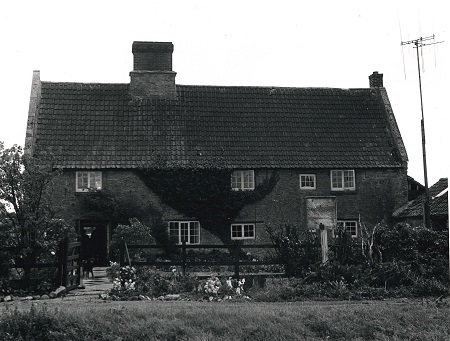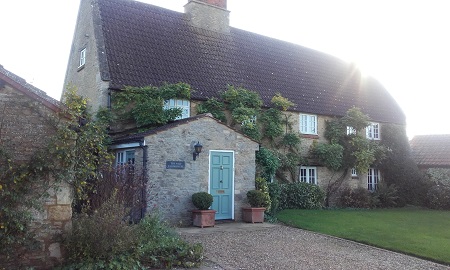Marsh Farm Carlton
This page was written by Pamela Hider.

Marsh Farmhouse, 1962 (Z53/25/10)
Background
As recently as the 18th century, The Marsh was the main route from Carlton to Turvey (see page on Old Roads from Carlton & Early Settlement). By the time of Enclosure in 1806, it had become a cul-de-sac with Marsh Farm at its end and it remains so today. In fact, The Marsh is an extension of The Moor and historically, the lane has also been referred to in records as Carlton Moor, Moor End and March End.
Along The Marsh are clusters of the older buildings in the parish. It is likely that there were more buildings along this road in the past, and that newer buildings have directly replaced older predecessors on the same plots, as there are many buildings present on the maps from the 18th to the 19th centuries. There also appear to be some toft and croft enclosures behind some of the houses. Those houses nearest Marsh Farm today could possibly once have been part of the farm estate, as on the 1806 enclosure map they appear very small (possibly to house farmworkers) yet on the 1926 valuation map are seen to be bigger and have very large outbuildings such as barns and even a coach house as well as other farm buildings. All the buildings along the Marsh were already very old enclosures and therefore would not have been subject to the enclosure award.
During the 19th century, much of the land in Carlton was owned by the De Grey family (Dukes of Kent) which evolved through Cowper to Lucas, so that by 1910, Lord Lucas was the major landowner.
Buildings
Ordnance Survey Maps surveyed in 1882/3 indicate that Marsh Farm consisted of several buildings on the west side of the farm house enclosing a farm yard, and grassland on the east side.
The Historic Environment Record for Bedfordshire describes Marsh Farmhouse as follows:
C17 house with C20 alterations. Coursed limestone rubble. Steeply pitched roof with stone gable coping now clad in C20 concrete tiles. 3-bay plan. Large double ridge stack serving back-to-back fireplaces in two eastern bays. Base of stack stone with red brick top added. Small gable end stack to W. end. Two storeys and attics. N. elevation: first floor has five casement windows with glazing bars. Ground floor, doorway to E. bay, four casement windows with glazing bars.
Census
In June 1841, the first census across the country, administered by the General Register Office, was taken and we find John (aged 31) & Sarah (aged 30) Title and their two daughters in Carlton Moor with elderly family members as part of their household. John's occupation was given as 'agricultural labourer' and Sarah's as 'lace maker'. John's father was William Title (died 1811) whose name appeared in land tax records from 1797 as tenant of Robert Eyles in Carlton Moor, an early address of The Marsh, so there is a possibility that this was at Marsh Farm, though no property details were recorded at that time. Our earliest record in which the name 'Marsh Farm' appears is the 1851 census where just John & Sarah Title are named as residents with their two teenage daughters. John is still an 'agricultural labourer' and Sarah and her daughters are all 'lace makers'. The 1861 census doesn't mention Marsh Farm by name, but lists the Titles as still being at 'March End', their daughters now having flown the nest.
By 1871, 'Marsh Farm' is mentioned again and The Titles are still there, next to Robert Pinkard (shepherd) & family. This is the first indication that the Farmhouse was then two semi-detached cottages. By 1881, the farm is listed under 'The Marsh' and the name Marsh Farm Cottages appears. Residents are James (shepherd) & Elizabeth Spencer & their son William (shepherd); and Robert Pinkard, aged 72, who is now alone and described as a watch repairer. The Titles are nearby, but now in their 70s and described as 'paupers'. The 1891 census refers to Marsh Farm Cottages Nos.1 &2. At no.1 is Michael & Ruth Burgess and their nephew William. No.2 is described as being uninhabited. Elizabeth Spencer is now a widow and living in the High Street and Robert Pinkard has died.
By 1901, the Burgess family had moved to Irchester and Marsh Farm is not mentioned by name in this census, nor in that of 1911 (nor in Electoral Registers). But the 1910 Finance Act Evaluation Records for Carlton (DBV1/25) tells us that the owner of Marsh Farm was Lord Lucas and the occupants' name was given in a single word - 'Reid'. Sure enough, in the 1901 census, listed under 'The Moor', were Harry & Mary Anne Reid and their two children. By the 1911 census, Mary Anne, aged 37, was a widow (Harry, also aged 37, had died in late 1909), but she was still at Marsh Farm, now with four surviving children, having lost three).
By 1913 the Lucas family had sold its estates in Carlton, Harrold & Turvey to Bedfordshire County Council and the land was split up into Council smallholdings, one of those being Marsh Farm. The next we hear of it is in September 1914, when in a smallholdings correspondence file (AO/C1/16), it is described as being in a 'delapidated state' and a year's notice to quit is served on William Mole. William had been licensee at The Carpenters' Arms just further along the Marsh , and after it closed in 1914, he became the last tenant of the Farmhouse before it was bought by Bedfordshire County Council.
Ratings & Valuation Act of 1925
Under this Act, every piece of land and building in the country had to be valued to determine the rates to be paid upon it. Property in Carlton was valued in 1927. At that time, the Occupier was J.Smith & Sons and it was remarked that the land was fair 'but quite a bit waterlogged'. The house was described as being stone & tiled and consisted of a Living Room, Kitchen and Scullery. Upstairs were 3 bedrooms and outside an Earth Closet and Barn. 'Water was pumped from a good well. Fair house for a small holding'. (This latter could refer to the time before the estate was sold off). Out-buildings consisted of: 'S. Implement hovel, E. Stable for 4, N. Cowshed for 4, 2 bay open shed, 2 piggeries, W. Chaff Barn, 2 bay open shed, hen house. Poor lot of buildings far too small'. Some of these had 'water from house'.
A document of 1935 (PK3/2/44/3) lists the outgoing tenants, J.Smith & Sons, and the ingoing tenants Messrs.Smith Bros. - Wilfrid, Sydney, Ernest and Harold. Landlords were still Bedfordshire County Council, but now also included Messrs. Fairey and Gaze. The document lists diverse and substantial farming stock. And fixtures now included an Iron Copper in the House.
Throughout the 20th century, the Council sold off its smallholdings, so that the house and land came into private ownership. A very detailed document of 1967-68 (AO/E7/2/4) contains the sales particulars of Marsh Farm.

Marsh Farmhouse, 2022